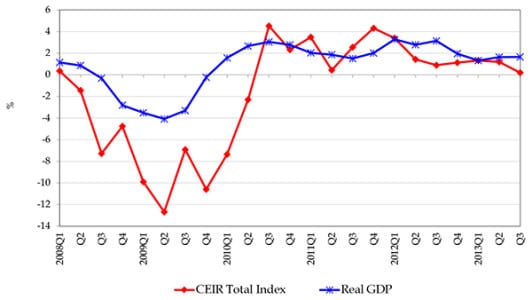Third quarter results for the Center for Exhibition Industry Research (CEIR) Index, a quarterly report on the exhibition industry, fell below projections increasing only 0.2 percent, approximately one percentage point lower than the previous three quarters and down from 0.9 percent during the same period in 2012.
Despite 13 consecutive quarters of growth, compared to the same quarter in 2012, three key metrics declined with only Real Revenues showing a slight increase.

“The paltry growth was due mainly to a 2.1 percent year-over-year decline in attendees, which in part is attributable to the budget impasse,” said CEIR’s economist Allen Shaw, Ph.D., chief economist, Global Economic Consulting Associates Inc. “Poor attendance appeared in many industries, especially the Government (GV) and Education (ED) sectors.”
Despite the decline in attendees, the other three metrics showed from a modest to moderate gain compared to the second quarter: Net Square Feet increased 0.6 percent, Exhibitors rose 0.2 percent, and Real Revenues gained 2.2 percent. In the 3rd quarter, the exhibition industry continued to lag behind the macro economy as real GDP gained 1.6 percent year-on-year.
The 2012 CEIR Index predicted slow growth in 2013, which has proven true, and that the exhibition industry may begin to grow steadily in 2014. The Index also noted concerns regarding the stability of the forecasted economic expansion and confirmed that the exhibition industry has rebounded from previous recessions, even though the industry tends to lag behind the economy’s recovery.

As an objective measure of the annual performance of the exhibition industry, the CEIR Index measures year-over-year changes in four key metrics to determine overall performance: Net Square Feet of Exhibit Space Sold; Professional Attendance; Number of Exhibiting Companies; and Gross Revenue. The CEIR Index provides exhibition industry performance across 14 key industry sectors: Business Services; Consumer Goods; Discretionary Consumer Services; Education; Food; Financial, Legal and Real Estate; Government; Building, Construction, Home and Repair; Industrial/Heavy Machinery and Finished Business Inputs; Communications and Information Technology; Medical and Health Care; Raw Materials and Science; Sporting Goods, Travel and Entertainment; and Transportation.





























